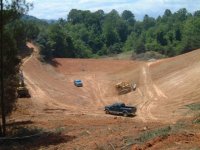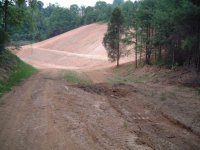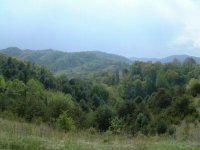SmokyMtMan, Congratulations and ditto on the other folk's complements. Should be beautiful when surrounded with green and filled with clear water. I too have a lot of red clay and it effects my ponds. With little or no exposed clay in the watershed for a pond I get fairly clear water (the bass can see submerged lures at a good distance and you can watch the 2-3 pounders in schools). Some of the ponds have disturbed earth in their watershed and they tend to get turbid after a rain depending on the amount of exposed material and the intensity of the runoff. Where the rural water district went through a seasonal creek with a track hoe they really played havoc with two of my largest ponds just downstream, one after the other.
A previous poster gave some excellant material on volumes, times, evaporation etc. Very informative and thought provoking. Here is some more to think on: Fine clay particles have charges and repel each other, resisting clumping together which would help make them fall out of suspension. The finer the material the longer it would take to settle out (volume vs surface area) without the particles repelling each other but with that effect you get lengthened settling times. Settling time for solids in suspension which cause turbidity can be thought of in "half lives" like radioactivity. Course materials like fine sand would have a half life in suspension of maybe 1/2 second. After say, 10 seconds, 1/2 X 1/2 X 1/2 X 1/2 X ...(1/2 times 1/2 , repeated 10 times) 1/1024 or 0.0009765625 which is less than one tenth of one percent would be remaining in the water after 10 sec. Unfortunately charged clay particles have a half life of something like a hundred years.
Some of us don't have the patience to wait several centuries after a rain for our ponds to settle and look clear enough. I have ponds of varying degrees of turbidity. One small one is a bright red paint pot all the time and never clears. Others have varying degrees of turbidity depending on the time since a heavy runoff.
There are strategies for clearing ponds. There are chemicals that cause particles to clump together but aren't economically practical for ponds as large as ours. Some folks (like movie makers, for their girl lin the desert water hole scenes) add blue dye to inprove the looks. Works, somewhat expensive, and doesnt clear water just makes it prettier from a distance. Rye straw works fair if done correctly and so on and so forth.
The best strategy is to elliminate as much of the problem at the source as you can. Get good soil holding grasses and whatever going on the watershed and be careful to not disturb the surface upstream of the pond.
You mentioned a drain pipe with a collar. That is good but I didn't read anything about your having an anti-vortex device on the drain pipe. If you do then, fine. If not, I strongly recommend that you contact your soil conservation district for the latest design and get it installed. As it goes on the end of the drain pipe inside the pond, you want to do that while the pond is dry to make getting there and working easier. Only one of my ponds needs a drain pipe and it has an anti-vortex device of older but effective design. The soil conservation district guy commented on the "dated" design and will provide info for update. Without one of these devices you can get serious errosion in short order AND significant muddying of the water in the pond in the process.
The recent farm bill that was passed (thanks George) should have dollars in it for certain assistance programs for which many of us might qualify. Related to ponds, there are programs for cost sharing for flood control ponds and errosion prevention and repair. As of last week the guidelines for the allocation of funds were still being drawn up in Washington D.C. but should filter down to local soil conservation district offices eventually. It would be prudent for anyone interested in this cost sharing program to get the tech out to investigate the situation in advance. As I only average one pond per 20 acres and still have a few "untapped" watersheds that would support a pond, I am interested in puting in more, in the words of the "Beatles", "I'll get by with a little help from my friends."
Solar equipment to do what you want may be prohibitively expensive but if a small flow over a waterfall is sufficient, that will not be a problem (during daylight hours). P-V direct pumping (no batteries) is quite effective for irrigation and potable water supplies (see back issues of "Home Power" magazine).
I went to the URL =
http://www.homepower.com and searched on "solar pump" and got 253 hits. Didn't have time to go through them all but from memory (I susbscribe) I can assure you there is a plethora of practical info on
solar powered water pumping, including from wells.
Best of luck to you AND PLEASE PLEASE PLEASE post followups with pix as it fills.
Patrick



